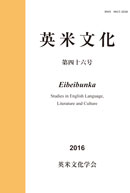Volume 35
Displaying 1-17 of 17 articles from this issue
- |<
- <
- 1
- >
- >|
-
Article type: Cover
2005Volume 35 Pages Cover1-
Published: March 31, 2005
Released on J-STAGE: June 20, 2017
Download PDF (24K) -
Article type: Appendix
2005Volume 35 Pages App1-
Published: March 31, 2005
Released on J-STAGE: June 20, 2017
Download PDF (4K) -
Article type: Index
2005Volume 35 Pages Toc1-
Published: March 31, 2005
Released on J-STAGE: June 20, 2017
Download PDF (21K) -
Article type: Article
2005Volume 35 Pages 5-21
Published: March 31, 2005
Released on J-STAGE: June 20, 2017
Download PDF (1054K) -
Article type: Article
2005Volume 35 Pages 23-34
Published: March 31, 2005
Released on J-STAGE: June 20, 2017
Download PDF (549K) -
Article type: Article
2005Volume 35 Pages 35-53
Published: March 31, 2005
Released on J-STAGE: June 20, 2017
Download PDF (1120K) -
Article type: Article
2005Volume 35 Pages 55-73
Published: March 31, 2005
Released on J-STAGE: June 20, 2017
Download PDF (1248K) -
Article type: Article
2005Volume 35 Pages 75-95
Published: March 31, 2005
Released on J-STAGE: June 20, 2017
Download PDF (1387K) -
Article type: Article
2005Volume 35 Pages 97-108
Published: March 31, 2005
Released on J-STAGE: June 20, 2017
Download PDF (689K) -
Article type: Article
2005Volume 35 Pages 109-124
Published: March 31, 2005
Released on J-STAGE: June 20, 2017
Download PDF (1106K) -
Article type: Article
2005Volume 35 Pages 125-144
Published: March 31, 2005
Released on J-STAGE: June 20, 2017
Download PDF (1174K) -
Article type: Article
2005Volume 35 Pages 145-156
Published: March 31, 2005
Released on J-STAGE: June 20, 2017
Download PDF (734K) -
Article type: Appendix
2005Volume 35 Pages 157-
Published: March 31, 2005
Released on J-STAGE: June 20, 2017
Download PDF (54K) -
Article type: Appendix
2005Volume 35 Pages 158-
Published: March 31, 2005
Released on J-STAGE: June 20, 2017
Download PDF (22K) -
Article type: Appendix
2005Volume 35 Pages App2-
Published: March 31, 2005
Released on J-STAGE: June 20, 2017
Download PDF (10K) -
Article type: Cover
2005Volume 35 Pages Cover2-
Published: March 31, 2005
Released on J-STAGE: June 20, 2017
Download PDF (21K) -
Article type: Cover
2005Volume 35 Pages Cover3-
Published: March 31, 2005
Released on J-STAGE: June 20, 2017
Download PDF (21K)
- |<
- <
- 1
- >
- >|
